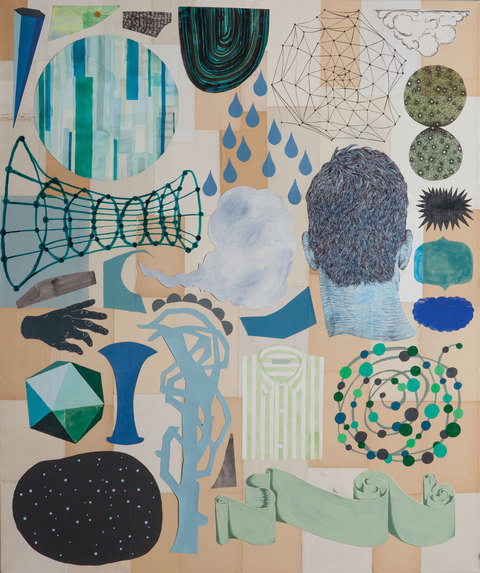The Locus exhibition explores meaningful points of intersection in the practices of five contemporary artists .
My purpose in selecting works in Locus primarily involves how grids, clusters and other aggregations inform experiences and impact the perceptions of viewers to reveal the artists' intentions, creating dialogue within and beyond the gallery space. The 'Locus' in this context is the point or set of points where significant forces are mapped out within works of art as well as how they relate to the museum walls.
Brian Hitselberger' site specific installation and paintings are compelling examples of the dynamics I am exploring in the exhibit. I caught up with him about the exhibit and other projects.
JLM: Comment on your practice and how it relates to the museum space?
B.H.: For the past several years, my studio practice has taken the form of works on paper and canvas on a variety of themes, and ephemeral wall-based installations that extend these themes into the architectural space of a museum or gallery. In this way one body of work drives another, allowing for explorations that begin in one form to be further explored in another.
Poet Contemplates the Sky
JLM: Comment on work on canvas, Nightmare and Daydream
B.H. Recent works on canvas, Nightmare and Daydream, were created with the intention of visualizing the types of associations that can occur in dreams. By using asymmetrical all-over balance within a loosely gridded picture plane, these works formally explore the types of meaning dream elements can create for the dreamer. No single element becomes compositionally significant, but rather it is the relationships between elements that begin to create some kind of meaning. This notion of a relational meaning comes out of my readings of Freud, as it opened a space for me to begin to understand the random and interlocking movements of the mind.
Daydream
At its core, my practice attempts to make thoughts visible. To function as a mineralization of the mind.
JLM: Comment on how this approach applies to your recent site specific installations
BH:These compositional strategies intrigued me on a two-dimensional surface, and I wanted to bring this formal organization to my next wall installation, which resulted in Hex. In Hex, the many objects the compose the piece bear little significance individually; it is only en masse that they begin to take on a kind of intention - that is, a form of mental protection. Politically and personally speaking, I have been aware of a rise in fear in myself and my queer brothers and sisters since the beginning of the current presidential administration. A rising intolerance of difference - something I have been conditioned to be attentive to as a gay man - has my alarm bells going off, to put it mildly. I find myself consumed with fearful thoughts on a regular basis, and have been actively resisting a tendency for these thoughts to give way to delusions of persecution, hyperbolic extremity, or untruth. And yet: I fear most of all that my fears may be ultimately justified.
Hex (not included in the exhibit)
These complex feelings are mediated through Hex, which brings together a collection of objects that bear resemblance to magical, protective talismans from other cultures. In referencing objects from cultures and histories outside my own, I am attempting to draw attention to the reality of fear itself as human phenomenon, one that is not new and has persisted (stubbornly) throughout human civilization. In being afraid, I align myself with others immediately, which works against the sense of isolation that so readily accompanies fear itself. How have we, as humans, dealt with fear? We have sought to protect ourselves through various means, sometimes through magical processes. Although I do not believe my work can magically protect me, I believe it can communicate a desire to be safe to a viewer. This communication, in my mind, can be a form of magic in itself. A viewer might recognize a similar dicer in herself, and a connection to a stranger might be made. This connection, more regularly referred to as empathy, seems to me to be what is most effective, most necessary in this moment.
For more information about the Northeast Georgia Arts Tour, visithttp://www.exploregeorgia.org/listing/46890-northeast-georgia-arts-touror call 706-947-1351. A sponsor of the event, the Mason-Scharfenstein Museum of Art will hold special Sundayhours on Sunday, June 11 from 12:00-5:00 p.m.





